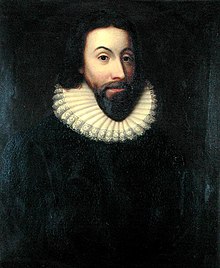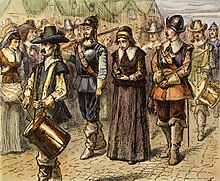Martyrs of Boston


In the tradition of the Quakers, the three English members of the Society of Friends Marmaduke Stephenson , William Robinson and Mary Dyer as well as William Leddra from Barbados , who were sentenced to death under the government of the Massachusetts Bay Colony because of their religious views, are called martyrs of Boston and were executed by public hanging in 1659, 1660 and 1661. Many other members of the group had also been sentenced to death in Boston at the same time, but could commute their sentence to be flogged in every city in the colony .
The hanging of Mary Dyer on the Boston gallows in 1660 marked the beginning of the end of Puritan theocracy and New England's independence from English law. In 1661, King Charles II explicitly forbade the state of Massachusetts from executing people because of their Quakerism. In 1684 England established the Massachusetts Charter and in 1686 dispatched a royal governor to enforce English law. In 1689 a law for a broad tolerance followed.
The origins of Boston
The Boston settlement was founded by chartered Puritan colonists from the Massachusetts Bay Colony under the direction of John Winthrop . The name of the town was given to it shortly after the Winthrop fleet arrived in 1630. It was named after the city of Boston in England . During the 1640s, when the English Civil War was at its height, the founder of English Quakerism, George Fox , discovered his religious calling. Under the Puritan Commonwealth of England led by Oliver Cromwell , the Quakers were persecuted in England, which is why in the 1650s many Quakers left as preachers of the truth .
Mary Dyer early on
Mary Dyer was a Puritan and lived in the Massachusetts Bay Colony near Boston. In 1637 she supported Anne Hutchinson , who believed that God spoke directly to individuals and not just through the clergy . They began organizing groups for Bible studies, but doing so was against the law in the colony. For this antinomic heresy , Mary Dyer, along with her husband William, Anne Hutchinson and others, were expelled from the colony in 1637/1638. They then moved to the Rhode Island Colony in Portsmouth with the religious community they founded .
The Speedwell's Journey
In 1656, eight Quakers, including Christopher Holder and John Copeland , came to Boston on a sailing ship called the Speedwell . The Speedwell was possibly the ship that initially set sail for America with the Mayflower in 1620 , but was forced to return to Plymouth to transfer the Pilgrim Fathers on board to the Mayflower . As required by Boston law, her arrival was officially announced. All newcomers were immediately taken to court and, once convicted, were detained for expulsion on the orders of Governor John Endecott . While in prison, Mary Dyer and Anne Burden arrived in Boston and were also jailed. After eleven weeks of detention, Holder, Copeland and the other six Speedwell Quakers were deported to England , from where they immediately organized their return.
The journey of the Woodhouse
In July 1657, the second group of Quakers, including six who had previously been on the Speedwell , landed on Long Island in Massachusetts . They came on the Woodhouse , which was piloted by her owner Robert Fowler from Bridlington Quay in Yorkshire , England. Five of them were put ashore in the Dutch part of Nieuw Amsterdam with encouraging words , namely Robert Hodgson , Richard Doudney , Sarah Gibbons , Mary Weatherhead and Dorothy Waugh .
Confrontations with Governor Endecott
Mary Dyer , who had traveled back to England with Roger Williams and John Clarke in 1652 , returned to Rhode Island with her husband in 1657. Holder and Copeland returned to Massachusetts and convinced other friends of their cause in Sandwich , but were arrested by John Endecott in Salem and thrown in prison for several months. After her release, she was arrested again in April 1658 in Sandwich and flogged. In June they went to Boston, where they were arrested again. In this context, Holder's right ear was cut off as a court-ordered punishment. When Anne Hutchinson's sister Katherine Scott sided with and defended them, she was also jailed and flogged.
Boston Laws Against Quakers
In late 1658, a narrow majority passed a law in Massachusetts by which any member of the "Quaker sect" who was not a resident of the colony but was found in their jurisdiction should be arrested and imprisoned by any police officer without a warrant . Those arrested should be expelled immediately on pain of death. Any resident of the colony found guilty of membership of the Quakers was to be jailed for a month and, if "stubborn" in his opinion, also expelled on pain of death. Some members of the Friends were arrested and evicted under these laws.
Stephenson and Robinson
Marmaduke Stephenson was a plowman in Yorkshire , England in 1655 when he felt he felt the love and presence of God as he followed the plow . He then left his family to serve the Lord and followed a prophecy to Barbados in June 1658 . After a while he heard about the new laws in Massachusetts and went to Rhode Island. There he met William Robinson , who had also been on the Woodhouse . In June 1659 the two of them moved to the Massachusetts colony with two other friends to protest the laws there. Mary Dyer came there independently with the same intentions. The three were arrested and banished, but Robinson and Stephenson came back and were arrested again. Mary Dyer returned to protest their treatment, but was also arrested. In October 1659, Endecott sentenced all three to the death penalty.
Executions on Boston Common
The day of execution was set to Thursday, October 27th. The weekly Church meetings in Boston were typically held on Thursdays. The gallows were in Boston Common . The prisoners spoke as they were led to the gallows, but their words were drowned out by drums .
William Robinson stepped up the ladder first. He told the people present that this was the day of their visitation and asked them to pay attention to the light in them, the light of Christ , his testimony, which he would now seal with his blood. Then he was interrupted by the Puritan pastor with the words: “ Hold thy tongue, thou art going to die with a lie in thy mouth. ”(“ Shut up, he will die with a lie in his mouth. ”) With his last breath, Robinson said:“ I suffer for Christ, in whom I live and for whom I die. ”(“ I will be executed for Christ, in whom I live and for whom I die. ”)
Next, Marmaduke Stephenson climbed the ladder and said, “ Be it known unto all this day that we suffer not as evil-doers, but for conscience sake. "(" Everyone should know on this day that we will not be executed as villains, but on the basis of our conscience. ")
In memory of these events, October 27th has been declared International Day of Religious Freedom , in order to regularly become aware of its importance.
Executions of Mary Dyer and William Leddra
Mary Dyer also stepped up the ladder, but when her face was already covered and the rope was tied around her neck, someone shouted, "Stop! Pardon her!" She was then returned to the court and exiled again, but returned in May 1660. Since then, other colonists and visitors had been sentenced to death, but the authorities did not carry out the sentence. Ten days after her return, Endecott sent to Dyer at the request of the court to ask if she was the same Mary Dyer who had previously been convicted. After she confirmed this, the death sentence was carried out. Born in Barbados, William Leddra was executed on March 14, 1661.
Others waited in prison to be sentenced but were released. A new law was enacted replacing the death penalty with flogging in every town in the colony. A short time later, the king's missive reached the city of Boston, demonstrating the royal disapproval of the Massachusetts policy of persecution.
literature
- London Yearly Meeting (Society of Friends): Christian life, faith and thought in the Society of Friends . Being the first part of the Christian Discipline of the Religious Society of Friends in Great Britain. Friends Book Center, London 1927, OCLC 8998920 , p. 28-34 .
- Joseph Besse: Joseph Besse . SN, London 1753, OCLC 80806970 .
- Ruth Talbot Plimpton: Mary Dyer . biography of a rebel Quaker. Branden Pub., Boston 1994, ISBN 0-8283-1964-2 .
Web links
- Louise Bernikow: Mary Dyer Hanged on Boston Common. In: WeNews. June 25, 2003, accessed December 4, 2011 .
- Mary Dyer: A Quaker Martyr. Retrieved December 4, 2011 .
Remarks
- ↑ It is not certain whether it was just the name or also physically the same ship.
Individual evidence
- ^ Francis J. Bremer, Tom Webster: Puritans and Puritanism in Europe and America . a comprehensive encyclopedia. ABC-CLIO, Santa Barbara 2006, ISBN 1-57607-678-4 ( limited preview in Google Book Search).
- ↑ Johan Winsser: Mary Dyer. Quaker Martyr and Enigma. 2008, accessed December 3, 2011 .
- ↑ Horatio Rogers: Mary dyer of rhode Iceland . the quaker martyr that was hanged on boston common, june 1, 1660. General Books, 2010, ISBN 978-0-217-01710-7 ( limited preview in Google Book Search).
- ^ John C. Shields: William Leddra. In: Henry Colin Gray Matthew, Brian Harrison (Eds.): Oxford Dictionary of National Biography , from the earliest times to the year 2000 (ODNB). Oxford University Press, Oxford 2004, ISBN 0-19-861411-X , ( oxforddnb.com license required ), as of 2007, accessed December 4, 2011. (not viewed).
